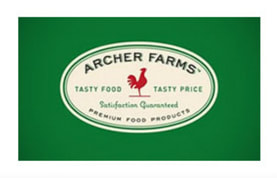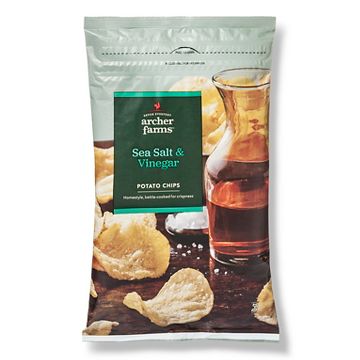Archer FarmsIn 1893, the Westminster Presbyterian Church burned down. It was this tragic event that leads to the Target stores of today.
To raise funds for a replacement church, the congregation persuaded a wealthy banker, George Draper Dayton, to buy an empty corner lot in downtown Minneapolis. Dayton built a six storey building and In 1902, Dayton attracted the Reuben Simon Goodfellow Company to move its Goodfellows department store into his new building. Goodfellow retired and sold the store to Dayton. Dayton Dry Goods Company was founded in 1903. The philanthropic owner ran the store on Presbyterian guidelines. There was no alcohol or work on Sundays. And although Dayton also gave most of his money to charity, by the 1920s the former banker’s enterprise had become a multi-million dollar business that filled the six-story building. George died in 1938, but by that time his son Nelson, had been involved with the business for fifteen years. The new President of the company had built the business into a $14million enterprise, while maintaining those strict Presbyterian principles. During Nelson’s tenure, he managed to keep the store stocked throughout World War II, which raised profits. The philanthropy continued, and he even donated the store’s metal sign to a scrap metal drive during those difficult times. By the end of the War, the staff had retirement plans and 5% of its taxable income was made payable to the Dayton Foundation. Nelson Dayton died in 1950, and his son Donald took over the presidency. Four of Donald’s cousins assumed senior roles so they could effectively run the company as a team. The Presbyterian principles were abandoned. To maintain its status and compete in a modern age, the business undertook a more radical, aggressive, innovative, costly, and expansive approach. In 1956, The Dayton Company opened the Southdale Center, the world’s first fully enclosed shopping mall. It was however the inspiration of senior manager John F Geisse, that led the company from that point to the Target Stores of today. Geisse developed the concept of upscale discount retailing and pitched this to consumers during the post-War boom years. The idea would really hit the erm, Target. The Dayton Company opened its first Target Store in 1962. Douglas Dayton was the first president of the new arm of the company, which opened with four stores. By 1965, there were five Target Stores and sales had reached $39million. By 1968, Target had expanded rapidly. It adopted a modern bullseye logo, Douglas Dayton returned to the parent company, and John Geisse left the company. Dayton was succeeded by William A Holder. Target Stores ended the year with 11 units and $130million in sales. Within a year, Target had undertaken a major mergers and acquisitions program and had merged with the Detroit-based J.L. Hudson Company that year, to become the Dayton-Hudson Corporation. It was the 14th largest retailer in the United States, with five major department store chains: Dayton's, Diamond's of Phoenix, Arizona, Hudson's, John A. Brown of Oklahoma City, Oklahoma, and Lipmans. The company offered Dayton-Hudson stock on the New York Stock Exchange. The Dayton Foundation changed its name to the Dayton Hudson Foundation, and Dayton-Hudson maintained its 5% donation of its taxable income to the foundation. By 1971, after Dayton-Hudson had acquired 16 stores from the Arlan's department store, sales across all its chains surpassed $1billion, with the Target chain contributing just a fraction. In 1973, Stephen Pistner became chief executive officer of Target Stores, and Kenneth A. Macke was named Target Stores' senior vice president. A rapid overhaul saw the Target discount chain become Dayton-Hudson's top revenue producer within three years. By the early 1980s, having previously focussed its expansion program in the central US, the company began expanding to the West Coast market by acquiring 33 FedMart stores in Arizona, California, and Texas. By the mid 1990s, Dayton-Hudson was the 4th largest retailer in the United States. Target Stores increased its store count to 736 units in 38 states and enjoyed $17.8billion in sales. By the end of the decade this had increased to 912 units in 44 states with sales of $26billion. |
Target
Archer Farms, Good & Gather, Market Pantry Address: Target Plaza South, 1000 Nicollet Mall, Minneapolis, Minnesota 55403, USA Phone: 612 696 5000 Website: www.target.com Email: Contact Form As of 2013, Target had 1,788 units in the USA, 68 in Canada, over 360,000 staff, and revenue of over $73billion. It also gave around $4million a week to charitable causes, which would certainly please founder George Draper Dayton.
The arm of the company we are most interested in is Target Brands, which owns and oversees the company's private label products, including grocery brand Archer Farms. As you will see from the scant offering below, the corporation is so large that there are some divisions that simply do not do a good enough job. The Archer Farms private label Potato Chips line provides clear evidence that someone is not paying the close attention to potential, that we at Chips & Crisps would if we were put in charge of it. |
|
|
|













